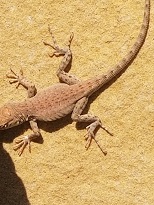Plateau Side-Blotched Lizard (Uta stansburiana uniformis)
Description: A small (up to 64 mm or 2.5" from snout to vent), orange-tan to gray-brown lizard. A dark blue-gray to black blotch marks each lower side of the body just behind the forelimb. Markings are variable and can include brown chevron-shaped blotches, light dorsolateral stripes, no pattern, and speckles. The lips and sides of the throat are often marked with alternating orange and gray to blue-gray stripes. The remainder of the underside is plain pale gray. Males often have bright turquoise blue speckling on the tail, back, and upper surfaces of the hind limbs. Females lack blue speckling and usually have light dorsolateral stripes. The scales on the body are small and mildly keeled. The scales on the tail are larger and more strongly keeled. The belly scales are smooth and flat and the scales on the top of the head are large and smooth.
Habitat: Habitats include a wide variety of arid and semiarid situations with scattered bushes and/or scrubby trees; soil may be sandy, gravelly, or rocky; the species is often found in sandy washes with scattered rocks and bushes. Eggs are buried in sandy soil.
Range: The geographic range extends from Utah, and western Colorado southward to the JUtah, Texas, and Arizona. Elevational range extends from below sea level in desert sinks to about 9,000 feet.
Diet: Side-blotched lizards are an opportunistic forager that waits for prey to wander within close proximity. It feeds on a variety of insects including grasshoppers, beetles, ants, and termites. It also eats a variety of spiders, scorpions, and occasionally some plant material.
Reproduction: Multiple clutches of eggs are laid in spring and summer. Clutch size ranges from 2 to 5 eggs. Hatchlings begin to emerge in June.
Status: Listed as Least Concern in view of the large and stable extent of occurrence, area of occupancy, number of subpopulations, and population size. No major threats are known.
»» Kingdom: Animalia - Animals
»» Phylum: Chordata - Chordates
»» Subphylum: Vertebrata - Vertebrates
»» Class: Reptilia - Reptiles
»» Order: Squamata - Lizards
»» Family: Phrynosomatidae - North American Spiny Lizards
»» Genus: Uta
»» Species: Uta stansburiana - Common Side-Blotched Lizard
»» Subspecies: Uta stansburiana uniformis - Plateau Side-Blotched Lizard
This article uses material from the Wikipedia article "Common Side-Blotched Lizard", which is released under the Creative Commons Attribution-Share-Alike License 3.0. Content may have been omitted from the original, but no content has been changed or extended.
|






